History
The oldest building of the Paramonov Warehouses was built in the middle of the 19th century and the last one was built in the end of the 1890s. [1] Warehouses were built by engineers Yakunin and E. Shulman. [1] During its lifetime warehouses belonged to various owners and companies, but urban legend is still attribute them to their one owner, famous grain-industrialist Elpifidor Paramonov. [1]
Warehouses miraculously escaped destruction from bombardments of port during the Great Patriotic War. Although one air bomb hit it, breaking the water-cooling system. [2] Warehouses were subjected to the most significant destruction during its abandoned existence. [1] Warehouses survived not less than five fires. [3] During the last days of USSR warehouses were used as intended directly, they were stored cement, building materials, etc. [2]
In 1985 the Paramonov Warehouses were assigned status of historical and cultural monument of local importance. [3] Later the historical monument acquired status of monument of federal importance.
Current state
All buildings of the Paramonov Warehouses are currently representing ruins [1] decorated with lakes and waterfalls of spring water, which is still welling out from the Don River’s coastal slopes. Because of the constant temperature, own microclimate on ruins of the Paramonov Warehouses was formed: green grass grows there almost all the year. [1]
In June 2011, on local enthusiasts’ initiative a cleaning litter activity “Augean stables” [4] was conducted on the Paramonov Warehouses. Legislative Assembly of the Rostov Region did not support the activity, considering this work illegal, but pop singer Natalya Vetlitskaya supported it. [4]
Storage of litter and domestic waste on the monument's territory still continues to this day. [5] In June 2012, Kirovsky district court of Rostov-on-Don satisfied regional Assistant Attourney's plaint to district ministry of culture and several other organisations, in which Assistant Attourney requested to develop a project of protection zones of monument of cultural legacy "The Paramonov Warehouses" and to set informational signs on it. [5] Ministry of Culture of the Rostov Region tried to appeal this decision, but in August 2012 full court of civil affairs of Rostov regional court left the appeal without satisfaction. [5]
In December 2013, Ministry of property of the Rostov Region approved the project of development and reconstruction of the Paramonov Warehouses. [6] The project of reconstruction was developed by one of the Moscow architect bureaus. [6] According to this project, during the reconstruction of the Paramonov Warehouses all buildings will be saved and the centre of contemporary art will appear on the territory. [6]
On 23 December 2015 it was leaked out that the Paramonov Warehouses might be completely demolished and then rebuilt again. In doing so, the new object would lose natural basin. This was announced by the head of city administration Sergey Gorban on regional organizing committee's meeting on preparation to World Cup 2018: "Conducted expertise showed that all building are in alarm condition and are liable to dismantling and reconstruction. Herewith the bath preservation is not planned". [7]
On evening of 28 January 2016, a message spread in social medias which said that the famous bath on the Paramonov Warehouses no longer exists. The proof of it was a video in which it is seen that the basin have been dismantled slowly and safely.
The administration of Rostov-on-Don made a comment on situation of the Paramonov Warehouses, beginning their story with prehistory of events.
«In the beginning of December 2015 the conference was held in Kirovskaya administration in the presence of regional head, his assistants, representative of law-enforcement agencies and persons in charge of PVT "Alliance-M" – the company leasing the warehouses.
It was said on conferences that local residents were constantly complaining of binges, brawls and robberies of naval school's students made by warehouses’ "guests", Besides, it was pointed out to the alarm condition of object and the quality of water – according to the conclusion of SES, the water was not suitable for drinking or bathing.
As a result, participants of conference came to general consensus: to let out water from unauthorized basin and to rail off building of the Paramonov warehouses for citizens’ safety. Deadline was also set – before 15 December, however PVT „Alliance-M“ met half-way with public and gave the opportunity to celebrate the holiday of Baptism with guarding of Kirovskaya OVD. As of today, water is let out from building, barriers were set all around. Entrance to the Paramonov Warehouses will be closed», as said in official message of department of information policy of Rostov-on-Don's administration.
The Paramonov Warehouses located on Beregovaya street is one of the most discussed objects in Rostov-on-Don. Society and bureaucracy are permanently exchanging allegations relating to the future of the warehouses.
Reconstruction of storage facilities was conducted by PVT «Alliance-M». Lease for a period of 45 years between company and the owner of the Paramonov Warehouses was concluded in the end of 2013. Grand total of planned investments is 1 billion 240 million rubles.
Company director Vladimir Bondarenko said that in place of ramshackle warehouses there can appear several hotels, concert and exhibition hall, spa complex with apartments and restaurant complex. According to concept which investor declared, two left warehouses should be reconstructed into hotels with apartments on upper floors with the view from the window on Don River. Building where rivers flowed and citizens bathed was planned to be made into spa complex with hothouses and restaurants should have been placed in front of them. Building of the most farthest warehouse, which preserved better than others, was suggested to be made into a multifunctional concert hall. It was planned to arrange a two-storied parking and technical zone under the whole complex of the Paramonov Warehouses.
Auction for sale of the Paramonov Warehouses is appointed on 31 Jule 2017. Starting price is 8,8 million rubles, which is comparable to the cost of one-room flat in Moscow. [8]
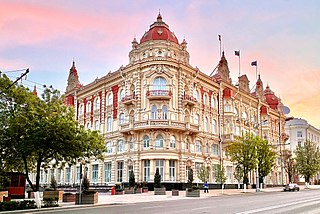
Rostov-on-Don is a port city and the administrative centre of Rostov Oblast and the Southern Federal District of Russia. It lies in the southeastern part of the East European Plain on the Don River, 32 kilometers (20 mi) from the Sea of Azov, directly north of the North Caucasus. The southwestern suburbs of the city lay above the Don river delta. Rostov-on-Don has a population of over one million people, and is an important cultural centre of Southern Russia.

Nikolai Paramonov mansion is a mansion in the city of Rostov-on-Don. It was built in 1914 for book publisher Nikolai Paramonov. The mansion was designed by architect Leonid Aeberg. The building is currently occupied by the Y.A. Zhdanov Scientific Library of Southern Federal University. The house is of Neoclassicist style and is considered to be an architectural monument of federal importance.
Monument to Alexander Pushkin in Rostov-on-Don ― a statue in the center of Rostov-on-Don. It is situated at the intersection of Pushkinskaya Street and Voroshilov Avenue. The author of the monument is Gavriil Schultz. The monument was erected in 1959. Later, the square where it stands was decorated with lanterns of 19th century style. Pushkin monument is an object of cultural heritage of regional importance. It is also the first monument in Rostov-on-Don which is dedicated to literary topic.
Monument to Stepan Razin is one of the monuments in the city of Rostov-on-Don, Rostov Oblast, Russia. It is dedicated to Stepan Razin, the leader of the peasant uprising of 1670-1671. The monument is also considered to be an object of cultural heritage.
Orthodox churches in Rostov-on-Don were built during the 17th–20th centuries; they played a decisive role in shaping of the architectural appearance of Rostov-on-Don. They created the high-altitude dominants which were really so important for each city. In addition, all the churches had their own unique style, reflecting the development of Russian art throughout the centuries.
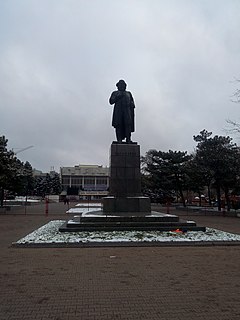
Monument to Karl Marx is a monument situated at Karl Marx Square in the city of Rostov-on-Don, Rostov Oblast, Russia. It was installed in 1959 at the site of the old Karl Marx Monument, which was destroyed during World War II. It is officially declared as an object of Cultural heritage of Russia.
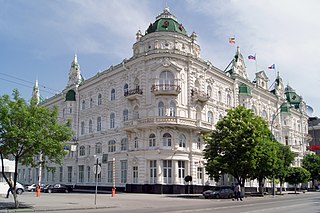
Bolshaya Sadovaya Street or Big Garden Street is the main street in Rostov-on-Don. Rostov City Hall, Rostov State Musical Theater, Southern Federal University, Chernova House and other notable buildings are located on this street. The street is parallel to the Don River.

Gazetny Lane is a lane directed from the south to the north in the center of Rostov-on-Don, Russia. It measures 2,1 km long, belongs to Oktyabrsky and Leninsky Districts and before the October Revolution was known as Kazansky Lane. During the NEP it became established as a red-light district.

Paramonov Mill, owned by the Russian entrepreneur Paramonov, was once located at the corner of Beregovaya Street and Posokhov Lane.
Monument to veterinarians is a monument in Rostov-on-Don in Russian Federation.

Theatre 18+ is a non-state theatre opened in Rostov-on-Don in January 2013.

Bogatuanovsky spring — a monument of history and nature in the city of Rostov-on-Don on the Bogatuanovsky descent, situated between Sedova Street and Beregovaya Street.
The Monument to Aleksandr Khanzhonkov is a bronze statue that is situated at Budyonnovky Prospect and Krasnoarmeyskaya Street intersection, near Marins Park Hotel, in Rostov-on-Don and commemorates Russian cinematographer Aleksandr Khanzhonkov. Statue was made by Rostov-on-Don’s sculptor and academician of Russian Academy of Arts Sergey Oleshnya. and unveiled on 24 August 2016.

The Burevestnik Cinema was a cinema in Rostov-on-Don, Russia, located at the intersection of Bolshaya Sadovaya Street and Voroshilovsky Prospekt.

The Administrative Building of Rostov (Warsaw) University is a building in Rostov-on-Don constructed in 1897. Initially it formed a part of the Nikolaev Hospital building complex. From 1915 it housed the Medical Faculty of the University of Warsaw, which had been evacuated to Rostov-on-Don during the First World War. It currently houses the administration of Rostov State Medical University and has the status of an object of cultural heritage of Russia of regional significance.

Don Embankment in Rostov-on-Don is situated on the right side of the river.

Ryndzyun hydropathic is a mansion in which a doctor Ilya Gilelevich Ryndzyun organized the first hydropathic institution in the city at the end of the 19th century. It is located on the Socialist street, 94 in the Kirov district of Rostov-on-Don. The house was of historical and architectural value, but eventually became in a critical condition, and then was completely demolished in 2014.
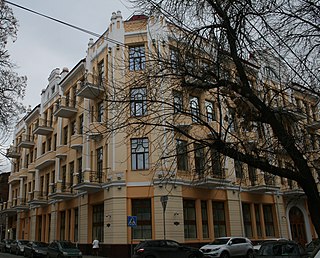
Srabionov's house is a building in Rostov-on-Don built in the 1910s on the project of the architect A. H. Zakiyev. Initially the house belonged to S.D. Srabionov, in him the Petrograd hotel was placed. As of 1925 it was DOMHA hotel "Business yard". From 1940th years the hotel carried the name "Don". Now the building occupies the Fifteenth arbitration Court of Appeal. In 2009—2013 in the building capital repairs were made. Srabionov's house has the status of an object of cultural heritage of regional value.

The Residential house of Nikolai Panin is a building in Rostov-on-Don which built in 1910 in modernist style.
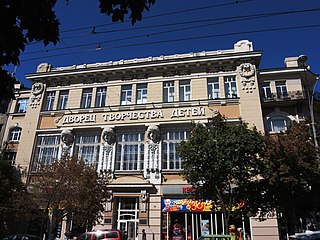
Volga-Kama Bank Building is a building in Rostov-on-Don constructed in Modern style in the beginning of the 20th century on the project of architect Alexander Beketov. It has the status of an object of cultural heritage of federal significance.















